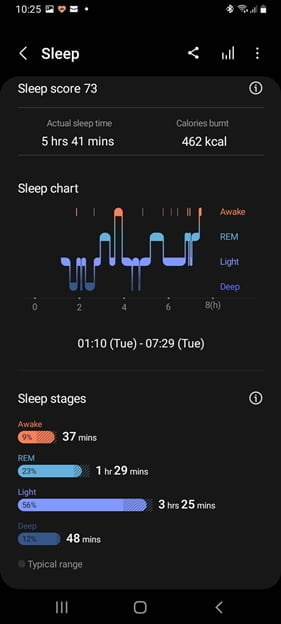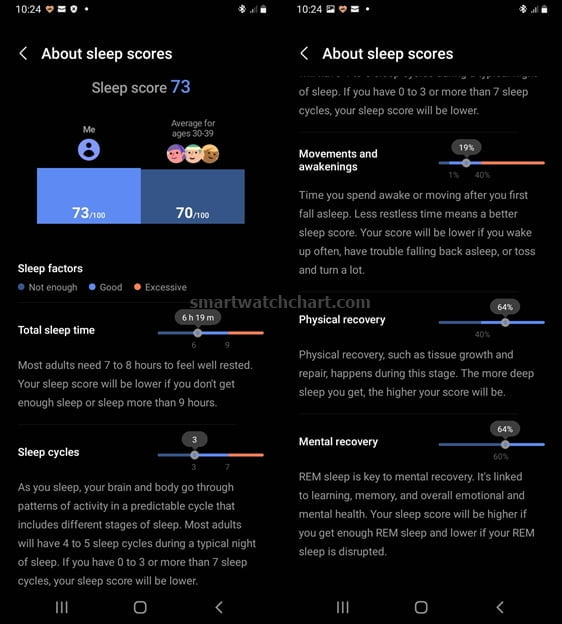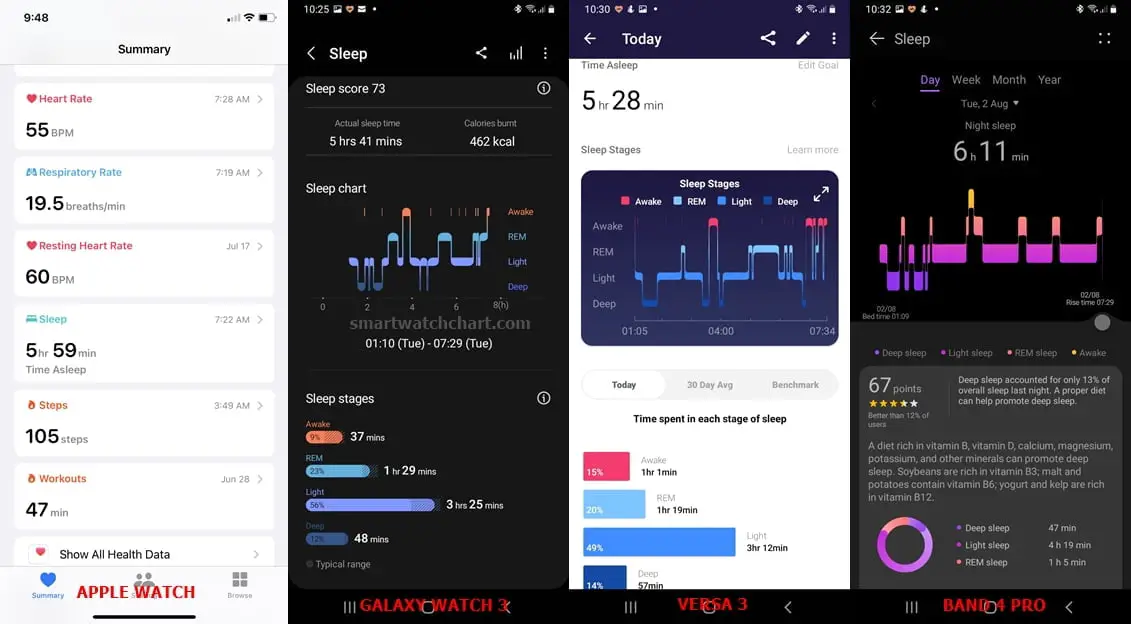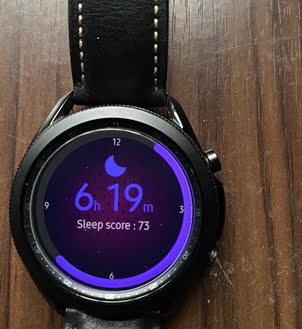Sleep is a very vital but often neglected part of one’s life that helps in the recovery and total well-being of an individual. Adequate amount of sleep can help minimize weight gain, reduce stress, prevent illness, heart disease and many other benefits. In today’s post, we’ll talk about how to track your sleep with the Galaxy Watch 3 and Galaxy Watch Active 2. We have also provided a guide on how to track your sleep with the Galaxy Watch 4.
How to Track Sleep With Galaxy Watch 3

Like other Samsung smartwatches, both the Galaxy Watch 3 and Galaxy Watch Active 2 will track your sleep in four stages; awake, light, deep, and REM stages. When you wake up from sleep, you will be able to see your sleep results directly on the watch. It shows your total sleep time, actual sleep time, and sleep score. You will need to go to the Galaxy Wearable app to see more details like your sleep history.
The Galaxy Watch 3 shows your total sleep time and actual sleep time, the difference is that the actual sleep time doesn’t include time spent in the awake stage.
You need to only wear your Galaxy Watch 3 or Active 2 to bed to track your sleep. In other words, any of these two will automatically track your sleep when you wear it to bed.
Unlike Active 2, the Galaxy Watch 3 just like the Galaxy Watch 4 series is equipped with a Spo2 sensor that enables it to track your blood oxygen. It can also monitor your blood oxygen during sleep. The Galaxy Watch 3 will track your blood oxygen during sleep and you will be able to view the result from the Galaxy Wearable app. This feature isn’t available in every country.
Sleep Stages Explained
Like we mentioned earlier, the Galaxy Watch 3 will track your sleep in four stages; awake, light, deep and REM stages. It will show the time you spent in each of these stages which is vital in helping you understand the quality of your sleep, this is unlike the native sleep app of the Apple Watch that only tracks your total sleep duration.
We’ll explain the meaning of each stage of sleep to give you a better understanding.
According to sleep researchers, there are five stages of sleep; Wake, N1, N2, N3 and REM stages. Sleep is further divided into Rapid Eye Movement (REM) and Non-rapid Eye Movement (NREM), the NREM stage of sleep comprises N1-N3.

Just like Fitbit, Samsung groups N1 and N2 under light sleep, while N3 represents deep sleep. So a typical sleep result on your Galaxy Watch 3 will show awake, light, deep, and REM sleep stages.
On average, human sleep comprises 4 to 5 cycles with each cycle averaging about 90-110 minutes. Each cycle progresses through N1, N2, N3, N2, and REM.
- Awake stage:
- Light sleep:
- N1 Stage: Constitutes about 5%
- N2 Stage: Constitutes about 45%
- Deep sleep (N3 stage): Constitutes about 25%
- REM sleep: Constitutes about 25%
The awake stage or stage W of sleep represents when our eyes are still open and the EEG recordings show that it’s characterized by beta and alpha waves.
The beta waves dominate when our eyes are still open, while alpha waves dominate when the individual becomes drowsy and closes his/her eyes.
Light sleep comprises the N1 and N2 stages of sleep, and it constitutes about 45%-50% of our total sleep.
The N1 stage is the lightest stage of our sleep. This stage is characterized by theta waves which starts when over 50% of the alpha waves are replaced by low-amplitude mixed-frequency (LAMF) activity.
In the N1 stage, you can still hear noises and can easily be woken up. Muscle tone is present in this stage and breathing becomes more regular.
The N2 stage is a deeper form of sleep than the N1 stage but is classified as light sleep because you can still be woken up by very loud noise. This stage makes up a major part of the sleep cycle. It starts short and lengthens as the night progresses.
The EEG recordings show that the N2 stage is characterized by the presence of sleep spindles, K-complexes, or both. Sleep spindles are brief and powerful bursts of neuronal firings that induces calcium influx into the cortical pyramidal cells. Studies believe sleep spindles play an important role in memory consolidation, specifically procedural and declarative memory.
Meanwhile, K-complexes are long delta waves that are known to be the longest and most distinct of all brain waves.
According to studies, the K-complexes have been shown to function in maintaining sleep and memory consolidation. Breathing and heart rate are slightly decreased and regular in this stage.
In summary, the light sleep stage is a very important stage of sleep. It comprises about 50% of total sleep time and plays a significant role in learning and memory consolidation.
The N3 stage also referred to as slow-wave sleep is the deepest form of sleep. It’s very hard to wake someone from sleep at this stage. This is also the stage where sleepwalking and bedwetting occur.
EEG recordings show that the N3 stage is characterized by low-frequency delta waves and it constitutes about 25% of total sleep. This stage is affected by age as older individuals tend to spend more time in the light sleep stage than the deep sleep stage.
The N3 stage which is a very important stage is when the body repairs itself. It’s in this stage that the body regrows tissues, builds bone, muscle, and strengthens the immune system.
Rapid eye movement (REM) sleep constitutes about 25% of total sleep. In this stage, the brain is very active, heart rate is increased, breathing becomes more irregular, and the eye moves rapidly (hence the name). However, the muscles are actually paralyzed during REM sleep.
It’s in this stage that dreaming occurs and the brain is rejuvenated. This is why when we don’t get enough REM sleep, the individual experiences a foggy and hazy mood.
REM sleep is characterized by beta waves which are very similar to the beta seen in the wakefulness stage, however, during REM, the muscle is paralyzed.
The first REM is typically about 10 minutes in the first sleep cycle, and it gets longer in the subsequent sleep cycles with the longest experienced in the last cycle.
REM sleep is also characterized by bloated penile in men and clitoris in women. When you get enough REM sleep, you wake up sound and bright with these refreshed feelings.
[su_list icon=”icon: heart” icon_color=”#2A0116″ indent=”0″ class=””]
- How to Download Watch Face to Galaxy Watch 3 [2 Methods]
- How to Reset Galaxy Watch Active 2 [Hard and Soft Reset]
- SMS, Calls, WhatsApp and Gmail Messages on Galaxy Watch Active 2
[/su_list]
Are you Getting Enough Sleep?
According to researchers, an adult needs 7-8 hours of sleep daily. So, you should aim to get at least 7 hours of sleep and an appropriate amount in each stage of sleep. In other words, the appropriate amount of sleep for an adult individual is as follows;
- 50% of 7-8 hours of light sleep which represents 3.5-4 hours of light sleep.
- 25% of 7-8 hours of deep sleep which represents 1.45-2 hours of deep sleep.
- 25% of 7-8 hours of REM sleep which represents 1.45-2 hours of REM sleep.
Samsung Sleep Score – What is it?

You will get a sleep score when you wear your Galaxy Watch 3 to sleep. This score is based on the following 5 factors.
- Total sleep time: You will get a higher score if sleep up to 7-8hrs, and you will get a lower score if sleep less than 7hrs or more than 9hrs (note that this is based on my age).
- Sleep cycles: You will get a low sleep score if your sleep cycle is lower than 3 or more than 7. Note that a typical night of sleep consists of 4-5 cycles of sleep.
- Movement and awakenings: This refers to time spent awake after you first fall asleep. Your score will be lower if you wake too often or toss and turn a lot.
- Physical recovery: Tissue growth and body repairs happen in deep sleep. You will get a higher score if you spend significant time in the N3 stage. In other words, if you get enough deep sleep, you will get a higher physical recovery score.
- Mental recovery: Memory rejuvenation occurs in the REM stage. You will get a high sleep score if you spend significant time in the REM sleep stage.
The Samsung algorithm comprises and averages these scores to give you a sleep score. The orange color indicates excessive sleep, the steel blue color indicates poor sleep while the sky-blue color indicates good sleep. You will also see the average sleep score for individuals within your age range.
Samsung Galaxy Watch 3 sleep tracking accuracy
To test the sleep tracking accuracy of the Galaxy Watch 3, I wore it alongside the Fitbit Versa 3, Apple Watch Series 7, and Band 4 Pro on several occasions. The results I got showed clearly that the Galaxy Watch 3 is consistent in tracking my sleep.

From the results I got, the Galaxy Watch 3 faired favorably against the other devices. It was consistent in tracking my total sleep time. However, I cannot confirm the sleep stage tracking accuracy of the Galaxy Watch 3 as this would require an EEG test which I don’t have access to.
Samsung Health sleep stages not measured (the reason)
Like other Samsung smartwatches, the Galaxy Watch 3 will only track your sleep stages if you get more than 4 hours of sleep. For anything less than 4 hours of sleep, the Galaxy Watch 3 will only track your total sleep time, but won’t track sleep stages.
Conclusion
Wrapping things up, the Galaxy Watch 3 will track your total sleep time, it will also track your sleep stages and blood oxygen during sleep. And in terms of accuracy, the Galaxy Watch 3 is an accurate and consistent sleep tracker.

